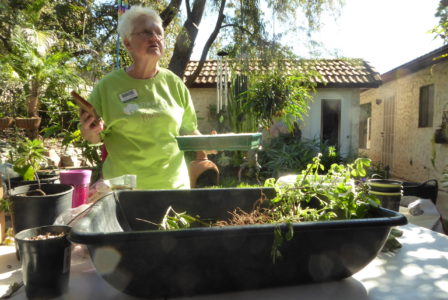Propagation: An addicting pastime.
Part 1: Sexual Propagation: Growing plants from Seeds

Ann Moore may use a flat shallow bed filled with Perlite, which she pre-moistens, to propagate plants.
On a sunny Saturday, Jill Schmidt, a fellow member of the Mission Hills Garden Club and San Diego Horticultural Society, and I drove to El Cajon for a propagation workshop. Anne Moore, English native but in the U.S. long enough to have lost most of her accent, gave easy-to-understand demonstrations of various ways to propagate plants and why one might choose to do so.
The main reason to propagate plants is that it’s free. However, there is a far more important reason to do so: to produce plants that are nearly extinct or which are difficult to find. There are growers who do nothing but search the world for lost plants and then attempt to propagate them.
Plants reproduce in two ways: Sexually and asexually. Moore spoke of sexual reproduction first. To reproduce sexually you need a mom and a dad. Seeds contain the genomes of both parents. Unfortunately, you have no guarantee that the seed will be exactly like its parents. Like people, some characteristics will come from the father, some from the mother.
If you are growing plants from seeds, you must be careful. If you have purchase a packet of seeds, read the directions. The most important aspect of planting seeds is the time to do so. If they should be sown in late February to mid-April and it is now May, wait a year. About 90 percent of the seeds in the current year’s packet will germinate. If you wait until next year and plant at the proper time, 80 percent should come up. Seeds have germinated that are hundreds, even thousands of years old. However, if it isn’t the right time, you will be lucky to get one plant.
Moore says that the Internet will tell you when and how to plant your seeds. Most seeds do best when planted dry. If you gather seeds from a pod, shake it vigorously. If the seeds rattle, they are ready. Otherwise, leave them on the parent plant until they are viable. Whether in a jar, a packet, or a pod, they should produce a nice rattling sound.
Seeds need to be kept moist while germinating. If you forget them and they dry out, they will die. Too much water can kill them. While most seeds die from too much water, tomato seeds thrive with a bit of mold. Perhaps this is because the tomato falls, and the seeds are still in the wet fruit. These seeds may be planted between damp pieces of paper towel.
If you have no packet with directions, the Internet will give you pointers. A rule of thumb is to plant the seed (or bulb) twice the depth of the seed (or bulb). Most seeds and bulbs should be planted in pre-moistened soil. Anne uses a pencil to push a small seed into the soil. Then she covers gently.
She warned us several times about over watering. She claims the best moisture gauge is your finger. The soil should be damp but not wet. It shouldn’t be dry either. Seeds need to be checked daily. Water them as needed. Anne cautioned us against thinking you didn’t water yesterday so you’d better water today. Never water without checking the soil first.
With the nurturing needed for growing from seed, Moore follows directions to the letter. She buys expensive organic potting soil. This she mixes with a little Perlite for better drainage. Her seeds are planted in a six-inch pot, three or four seeds to a pot spaced evenly. She may use a flat shallow bed filled with Perlite, which she pre-moistens. If she uses Perlite, she avoids watering for a week.
Once the plants have grown a few inches or so and have a few leaves, carefully dig each one up with the soil stuck to its roots and transfer it into a larger pot. Each time she repots the plant, she adds a bit of soil from her garden. Her aim is to wean the plant from its organically rich baby formula to the soil it will live in for the rest of its life. The only plants that never have ordinary soil are her vegetables. They are grown in raised beds with the best soil she can buy.
When you are planting, remember that some plants do not flower on new wood. This means it may be a year or two before you get blooms. (Our avocado trees took three years. They produced prolifically when we sold the house. We never got to taste one.)
Many of us had questions. Several people wanted to know if there were seed exchange clubs. Moore said DavesGarden.com is a web site not unlike Match.com where you can find what you want. His web site has a “community forum” for seed exchanges.
Next month’s article will be about asexual propagation. The March 22 Garden Club meeting will be about planning a vegetable garden with the Red Door. Please look at the Mission Hills Garden Club website, missionhillsgardenclub.org for more details.
Category: Local News







